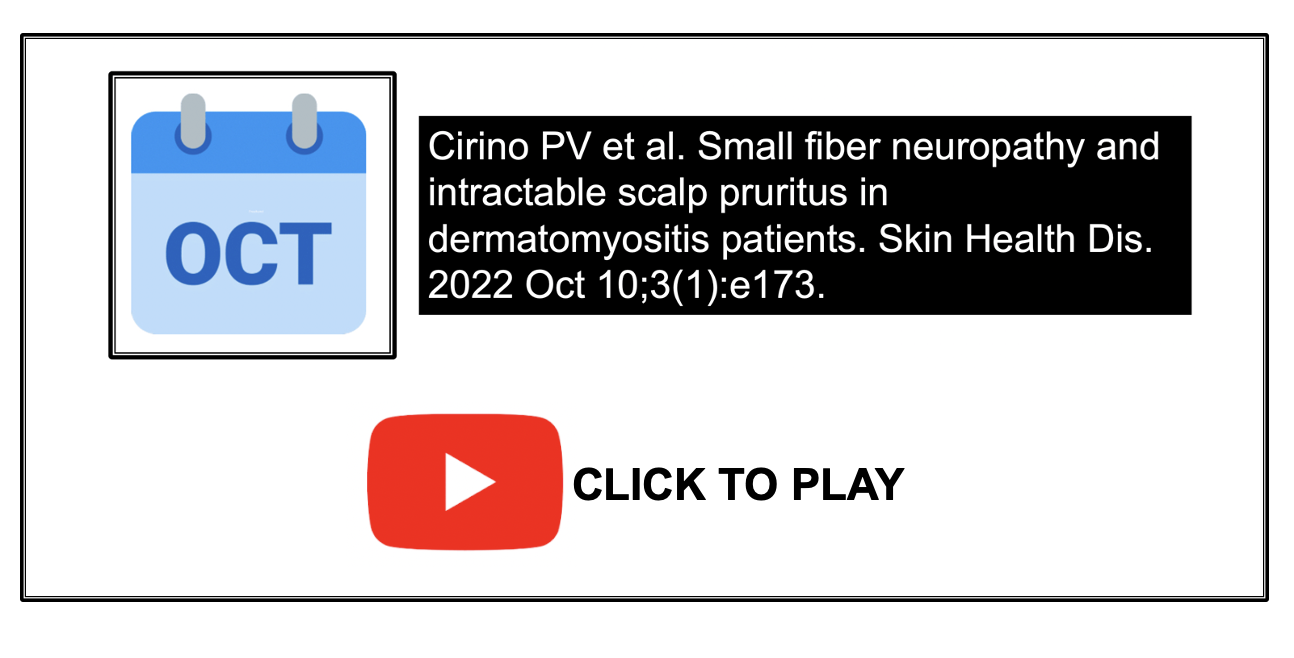New Insights into Scalp Itching in Patients with Dermatomyositis.
Reduction in Nerve Fibers May be Basis to Treatment Resistant Pruritus in Scalp Dermatomyositis
Dermatomyositis (DMS) is a chronic autoimmune disease. The incidence is estimated at around 1 in 100,000. Dermatomyositis can affect children and adults. It commonly affects persons between the ages of 40 and 50. The condition is more common in women than in men.
DMS is a systemic disease that can affected many organs. The name of the disease highlights its effects on skin and muscle and patients with DM present with characteristic skin findings (Gottron papules, Gottron sign, shawl sign heliotrope rash) and a symmetric proximal skeletal muscle weakness. DM can affect many other organs and structures including joints, esophagus, lungs, heart and blood vessels.
Scalp Involvement is Common in DM and Often highly Resistant to Therapy
A 1994 study by Kasteler and Callen highlighted the frequent involvement of the scalp in DM patients. The authors of that study showed that itchy scalp involvement was common manifestation of dermatomyositis (DM). They showed that a “diffuse, scaly dermatosis with erythema atrophy, and often nonscarring alopecia” was present in 82% of their patients with DMS.
Tilstra and colleagues in 2009 found that 15 of their 24 DM cases (62.5%) had scalp involvement. One-third (n = 5) of these 15 patients showed a nonscarring hair loss. All 15 of these patients were female (with mean age, 55.3 years). Scalp disease in the Tistra et al study was highly resistant to treatment. For example, of 13 patients who received high-potency topical steroid treatment, only 1 had a partial response. Of 11 patients treated with oral immunosuppressive agents, only 4 showed improved cutaneous symptoms but without scalp improvement.
Of 10 patients receiving hydroxychloroquine, none had resolution of scalp symptoms. 2 of 7 patients showed a partial response to methotrexate and 1 of 5 patients showed partial response to mycophenolate mofetil. The only full resolution of scalp symptoms was seen with intravenous immunoglobulins in a patient for whom all other therapy had previously failed.
Scalp Itching in DMS
Scalp itching is common in DMS. Some authors have reported cases of severe pruritus in the scalp of up to 71% of the patients with DM. This too can often be resistant to standard immunosuppressive therapy. In addition to itching, abnormal skin sensations, such as severe crawling or burning sensations can be present. These symptoms suggest abnormal epidermal nerve fibre function.
Cirino PV et al. 2022
A new study set out evaluate possible reasons for scalp symptoms in DMS patients and did so by evaluating epidermal nerve fiber density in 15 patients with DM compared with 12 healthy controls.
15 patients with DMS and scalp pruritus were eligible for inclusion in the study, and they were compared to the 12 healthy volunteers. Patients with DM had scalp pruritus without improvement by the existing treatments. Participants in the DMS group were older than the healthy control group (55.9 vs 31.6; p < 0.001); however, there was no difference in gender between groups. There were 13 (86.7%) female patients in the DMS group vs. 7/12 (58.3%) in the healthy control group (p = 0.220). Biopsies were taken from two areas via punch biopsy. One was from the parietal region, two centimeters above the right ear and one was from the occipital region, above the occipital protuberance. Vertical sections of the biopsy specimens were then incubated with primary antibodies to PGP 9.5 to visualize epidermal nerve fibers (ENF) and antibodies to CGRP and SP to visualize dermal nerve fibers.
Epidermal Nerve Fiber Density Lower in DM Compared to Controls
Epidermal nerve fiber density was lower in the parietal region in DMS patients compared to controls. There was even a greater reduction in ENF density in occipital region of DMS patients compared to controls. (p < 0.001)
Conclusion
This study showed that patients with dermatomyositis had reduced epidermal nerve fiber density compared with healthy controls. This study is important as it gives important clues to the basis of itching in DMS and why it is often so highly resistant to therapy.
This data highlights the occipital area as being a particularly common sight for reduction in ENF density.
All in all, the authors proposed that Small nerve fiber neuropathy could be an explanation for the recalcitrant scalp pruritus in Dermatomyositis patients.
REFERENCE
Cirino PV et al. Small fiber neuropathy and intractable scalp pruritus in dermatomyositis patients. Skin Health Dis. 2022 Oct 10;3(1):e173.
Kasteler JS and Callen JP Scalp involvement in dermatomyositis: often overlooked or misdiagnosed. JAMA 1994;272: 1939-1941.
Engel et al. Characteristics of patients with dermatomyositis from 2011-2021 at a tertiary care center. Dermatol Online J . 2021 Nov 15;27(11)
Tilstra JS et al. Scalp dermatomyositis revisited. Arch Dermatol. 2009 Sep;145(9):1062-3.
This article was written by Dr. Jeff Donovan, a Canadian and US board certified dermatologist specializing exclusively in hair loss.

